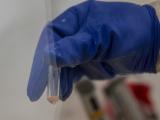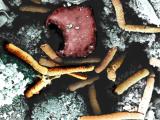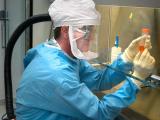Aug 27, 2002 (CIDRAP News) Researchers at Rockefeller University report that they have isolated an enzyme from a bacteriophage that shows promise as a tool to quickly detect and kill Bacillus anthracis, the anthrax bacterium.
Writing in the Aug 22 issue of Nature, Raymond Schuch and two colleagues state that an enzyme called PlyG lysin can be used to identify B anthracis in a few minutes and kills the organism in vitro within 15 minutes. The enzyme's action is highly specific to B anthracis and a closely related strain of Bacillus cereus, the authors say. Further, the enzyme was an effective treatment for mice infected with the B cereus strain.
"This enzyme is almost as effective as pouring bleach over these organisms," Schuch said in a Rockefeller University news release. "There is no other known biological agent that kills this quickly." The researchers also say that anthrax is unlikely to develop resistance to the enzyme, because it attacks fundamental components of the bacterium's cell wall.
After infecting a bacterial cell and multiplying within it, bacteriophages (viruses that infect bacteria) use enzymes to puncture the cell wall and release new copies of the virus. The authors identified PlyG by screening a library of proteins from the gamma phage, a member of a family of double-stranded DNA phage associated with B anthracis. PlyG (for "phage lysin gamma") was then applied to samples of B anthracis and a closely related B cereus strain called RSVF1, which may represent B anthracis without its virulence plasmid. Other B cereus strains and Bacillus thuringiensis specimens were also exposed to the enzyme.
Both B anthracis and RSVF1 were susceptible to PlyG, and one other B cereus strain that was closely related to B anthracis was slightly susceptible, but all other types exposed were resistant. Because RSVF1 shared this susceptibility and several other features with B anthracis, the authors concluded that it "is an appropriate representative of the gamma-phage-sensitive B. anthracis cluster of B. cereus for use in this study." The press release notes that RSVF1 was chosen for study because it is easier to work with than B anthracis and because it could be studied at Rockefeller, whereas B anthracis had to be tested at the Centers for Disease Control and Prevention.
A sample of 10,000 RSVF1 cells was "nearly sterilized" after 15 minutes of exposure to a solution of PlyG, while most other types tested remained "largely resistant" after 3 hours, the report says.
The authors tested PlyG in mice by injecting them with 1 million RSVF1 cells. Untreated mice died within 5 hours, but mice injected with 50 units of PlyG 15 minutes after the pathogen dose fared better: 13 of 19 (68%) recovered fully, and the others survived 6 to 21 hours. When the PlyG dose was increased to 150 units, 77% of the mice recovered. No toxic effects were seen when mice were injected with PlyG alone.
PlyG can also be used in combination with L-alanine, a germination agent, to kill anthrax spores, according to the report. The authors treated spores of RSVF1 and several other organisms (including other strains of B cereus, B thuringiensis, and Bacillus subtilis) with L-alanine or D-alanine, a germination inhibitor, for 5 minutes, and then exposed them to PlyG for 5 minutes. The germinating RSVF1 spores were nearly all killed, while the other germinating spores and all the D-alanine-treated spores survived.
The researchers took advantage of the enzyme's spore-killing ability to develop a hand-held luminometer to detect spores or cells sensitive to PlyG. Adenosine triphosphate (ATP) released from ruptured spores emits light in the presence of luciferin/luciferase, the article says. When RVSF1 and the other species were treated with L-alanine and then PlyG, the RVSF1 spores generated a signal 5 minutes after the PlyG treatment, while the other organisms did not. "The sensitivity of this system was demonstrated using as few as about 100 RSVF1 spores, which yielded a signal 60 min after the addition of PlyG," the report says. Further, treatment of vegetative RVSF1 cells with PlyG led to a light signal within 10 seconds, the authors say.
To test for development of resistance to PlyG, the researchers treated RVSF1 with methanesulphonic acid ethyl ester. This led to large increases in resistance to novobiocin and streptomycin but induced no resistance to PlyG. In light of this and other findings, "Intrinsic PlyG resistance is . . . unlikely, supporting a theory that lysins target essential cell-wall molecules to ensure release of progeny phages," the researchers state.
"Our findings encourage the continued development of PlyG as a means to prevent or treat anthrax and as a tool to detect vegetative or spore forms of B anthracis," the researchers conclude. They add, "Bacteriophages, and their corresponding lytic activities, represent an enormous untapped pool of agents with which to control human pathogens." Their study was funded by the Defense Advanced Research Projects Agency of the US Department of Defense.
Schuch R, Nelson D, Fischetti. A bacteriolytic agent that detects and kills Bacillus anthracis. Nature 2002;418:884-9 [Abstract]




















